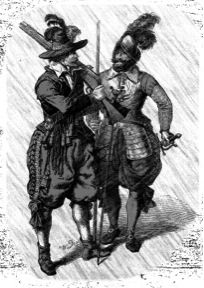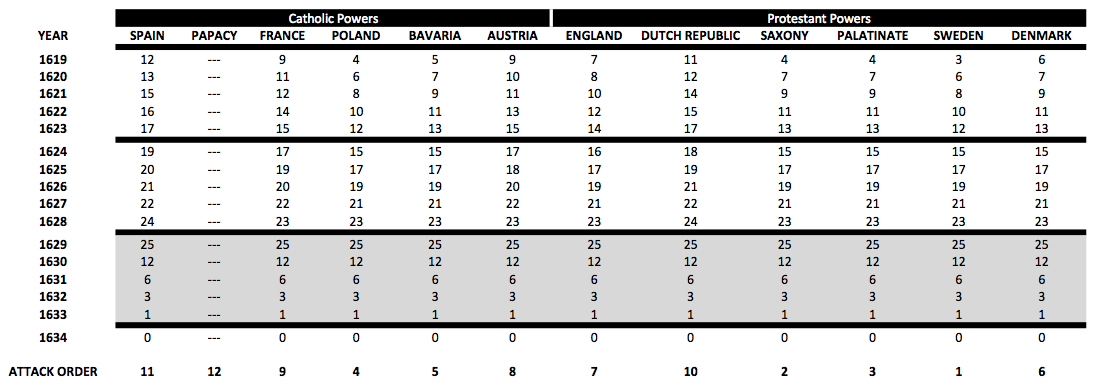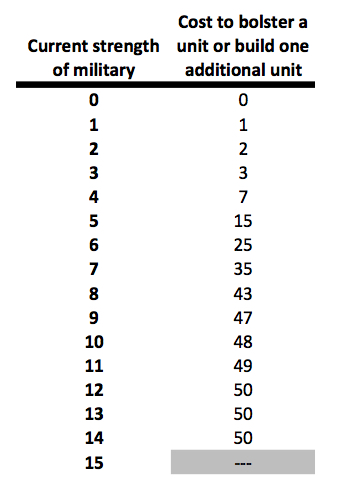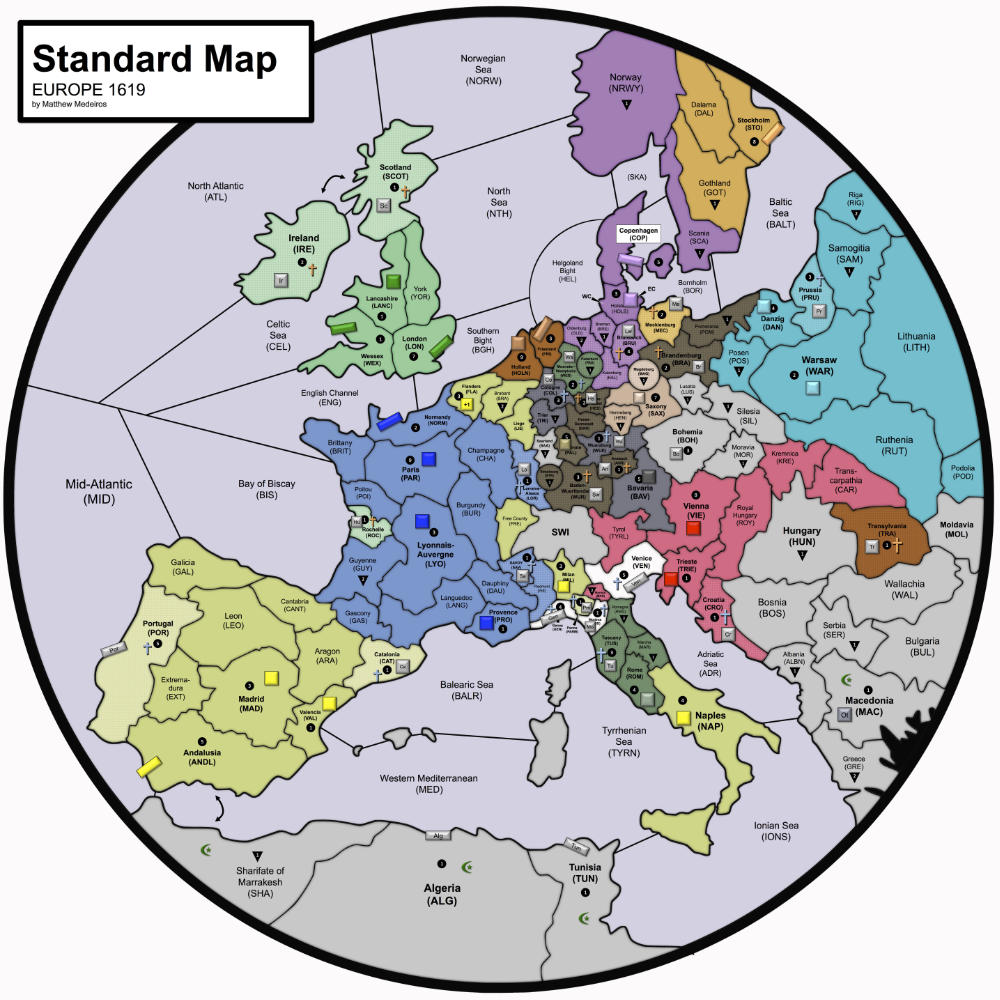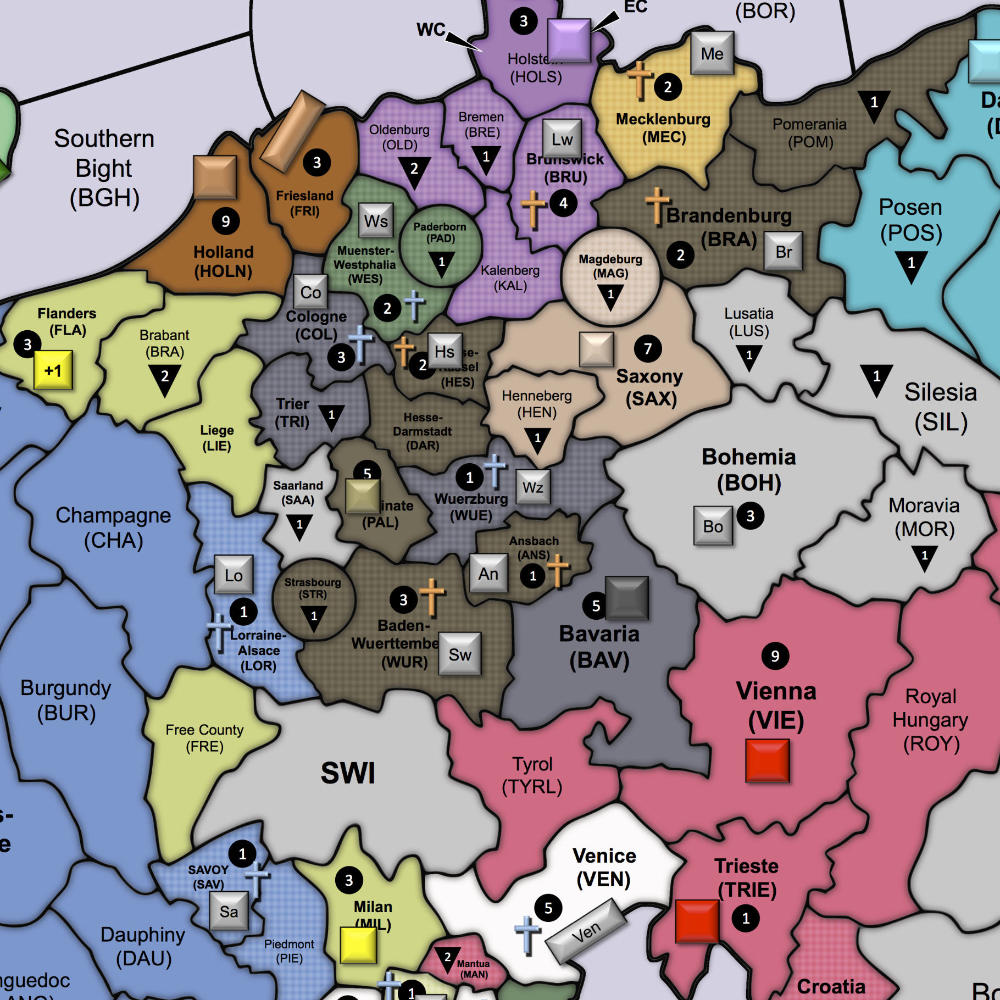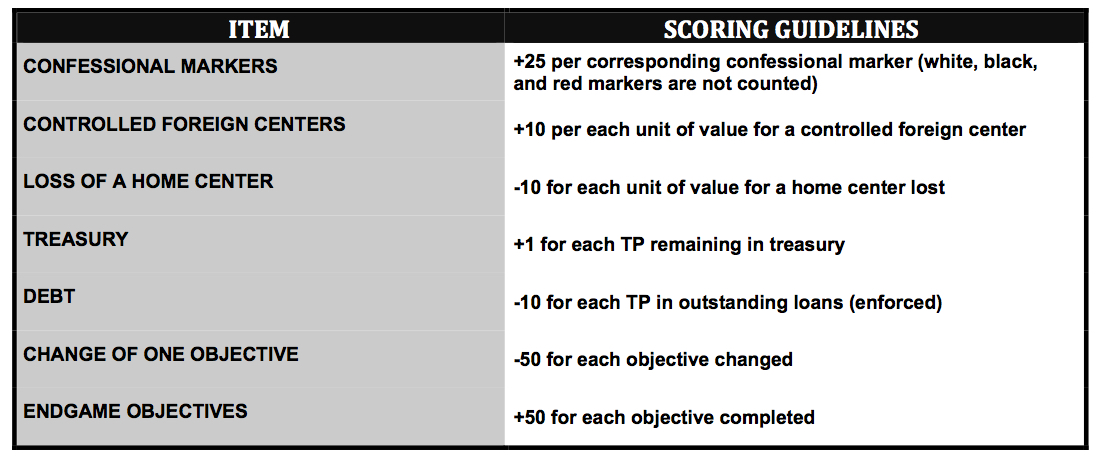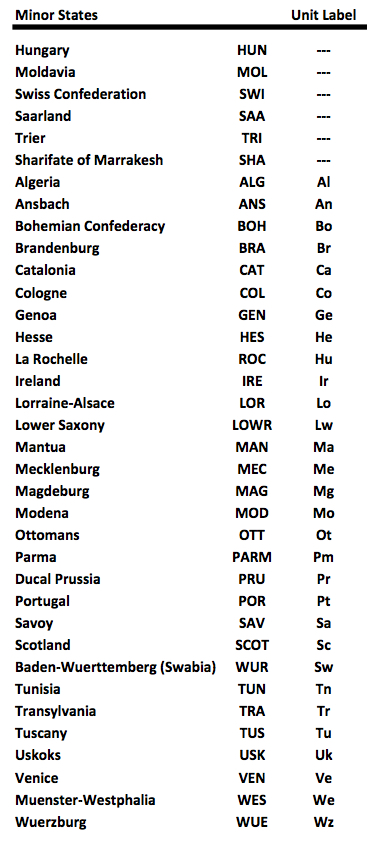Difference between revisions of "Europe 1615: Prelude to War"
| Line 259: | Line 259: | ||
'''Occupation by proxy:''' Since a power or minor needs to maintain occupation of a foreign province to maintain control, how can a power/minor maintain control if the occupational unit needs to move? You can substitute an aligned minor unit for your unit in a foreign province/center, or an ally’s unit, or a unit aligned with your ally, and thus you may still maintain control of the province or center. | '''Occupation by proxy:''' Since a power or minor needs to maintain occupation of a foreign province to maintain control, how can a power/minor maintain control if the occupational unit needs to move? You can substitute an aligned minor unit for your unit in a foreign province/center, or an ally’s unit, or a unit aligned with your ally, and thus you may still maintain control of the province or center. | ||
| − | + | ==Moving a bolstered unit== | |
| − | |||
| + | A unit with bolstered strength is not treated as multiple units when moving on the board, but as a single unit with greater strength than 1. The unit cannot be split apart (however, its strength may be reduced by a retreat), nor can it merge with others. The bolstered unit moves, attacks, defends, and supports with the greater strength. When a unit has greater strength this is depicted on the board with plus sign and value on top of the unit. So a unit with a strength of two is shown with a +1 on the top; a unit with a strength of 3 is shown with a +2 on top, etc. The maximum that a unit may be bolstered to is 10 (labeled with +9). Additionally, the support provided by a bolstered unit can be broken by an attacking unit (or the combined strength of attacking units) in a one-to-one reduction (i.e., if a unit supporting with strength of 2 is attacked by a unit of strength of 1, then the support given will be rated at 1). | ||
==RETREATS AND THE ATTRITION RULE== | ==RETREATS AND THE ATTRITION RULE== | ||
Revision as of 01:08, 29 December 2017
THIS PAGE IS BEING EDITED
EUROPE 1619 (formerly called Europe 1615)
A DIPLOMACY VARIANT
by Matthew Medeiros
INTRODUCTION
“Had Luther and Calvin been confined before they had begun to dogmatize, the states would have been spared many troubles.” - Cardinal Richelieu
July 31, 1619: Protestant leaders in Bohemia feared the fervent Catholic Ferdinand II, successor to Matthias, Emperor of the Holy Roman Empire, King of Bohemia and Hungary would infringe on their rights. The Bohemian revolt was already in motion, and a confederacy was hatched with Moravia, Silesia, and Lusatia, seeking support, and a leader. The following month, Calvinist Frederick V of the Rhenish Palatinate is elected king of Bohemian and prepares for war, hoping for international support. Will the Empire’s political and military influence suppress the cause, or maybe, just maybe, events will play out very differently in the hands of shrewd diplomats at the game table…
Europe 1619 is a Diplomacy variant that adopts the mechanics from Jim Dunnigan’s and Thomas N. Shaw’s diplomatic game Origins of World War 2 published in 1971. Europe 1619 is also inspired by other Diplomacy variants: Ambition and Empire, Classic Payola, Machiavelli, Multiplicity, and Formal Diplomacy. Europe 1619 is best played with 11 players. Each player represents one of eleven European major and regional powers of the early 17th century:
1 Austria, House of Hapsburg, Ferdinand II
2 Denmark, House of Oldenburg, Christian IV
3 Spain, House of Hapsburg, Philip III
4 France, House of Bourbon, Louis XIII
5 Dutch Republic, House of Orange-Nassau, Maurice of Orange
6 England, House of Stuart, James I
7 Sweden, House of Vasa, Gustav II Adolf
8 Catholic League, House of Wittelsbach, Maximilian I
9 Protestant Union & Bohemian Confederacy, House of Palatine-Simmern, Frederick V
10 Papacy, House of Borghese, Pope Paul V
11 Poland-Lithuania, House of Vasa, Sigismund III
Europe 1619 utilizes the standard rules from 5th Edition Diplomacy with modifications described in this rulebook.
OBJECT OF THE GAME
As soon as one power scores X points, it is considered to have gained control of Europe. The player representing that power is the winner.
However, a draw between all remaining players results if no single player is able to achieve the X points by the end of the year 1648; or by agreement prior to the year 1648.
NOTES ABOUT THE GAME BOARD
Large minor states: Several minor states are composed of smaller provinces as shown below. When a political status is established for these states, all provinces of the state are identified as aligned or neutral.
Lower Saxony (LOWR) = Kalenberg (KAL), and Brunswick (BRU)
Savoy (SAV) = Savoy (SAV), and Piedmont (PIE)
Hesse (HES) = Hesse (HES), and Darmstadt (DAR)
Ottoman Empire in the Balkans (OTT) = Macedonia, Greece, Bulgaria, Serbia, Albania, Bosnia, and Wallachia.
Coastal province: Holstein (HOL) has two coasts. Moving a fleet from Copenhagen (COP) to HOL requires that the coast be specified. HOL (EC) – HOL (WC) or visa versa is not a legal move.
Copenhagen: COP connects directly with Scania (SCA), Bornholm (BOR), Skagerrak (SKA), North Sea (NTH), Helgoland Bight (HEL), and Holstein (HOL). Moving a fleet from BOR to SKA will require going through SCA or COP.
Supply centers: Each supply center is marked with a solid circle inscribed with a number. These markers (1) determine income during the Builds and Transactions Phase, (2) determine which minor states can support a build, and (3) are required for the Scoring Phase.
Valued regions: Some provinces and most water regions are marked with an inverted triangle inscribed with a number. These markers (1) determine income at the Builds and Transactions Phase, and (2) are required for the Scoring Phase.
Confessional markers: Minor states will receive a Protestant marker (orange cross) or Catholic marker (blue cross) to indicate which confession has the two-thirds majority of influence in state.
UNITS AND TOTAL MILITARY STRENGTH
Each army unit is represented by a square piece. Each fleet unit is represented by a narrow rectangular piece. All units of the minor states (a.k.a., minor units) are represented by sliver-colored pieces with the abbreviated name of the minor state inscribed. Units of the powers (a.k.a, major units) are designated by color as listed below:
Austria = RED
Denmark = PURPLE
Spain = YELLOW
France = BLUE
Dutch Republic = BROWN
England = GREEN
Sweden = ORANGE
Catholic League = DARK GREY
Protestant Union = BRONZE
Papacy = DARK CYAN
Poland-Lithuania = BRIGHT CYAN
All units have the same strength at the start of the game. However, major army units may be bolstered to have a greater-than-one strength (or bonus). This would be indicated by an inscribed number with a plus sign on the army unit. These units will attack, defend, and support with a strength equal to one plus the value inscribed on the unit.
A minor army unit’s defensive strength may be bolstered by a power when creating a fortified province. When a minor unit receives a bolstering in its defense, the piece is replaced with a “shield” piece with defense bonus inscribed. A bolstering in the defense adds to the minor army unit’s defensive strength.
There can be only one unit in a province at a time, and an army unit's strength (or defense) cannot exceed 10.
A power’s total military strength is the sum of all of its individual unit strengths on the board.
STARTING POSITIONS
Centers and units: At the start of the game, each power controls one or more centers and valued provinces. Refer to the map for the starting positions of the units.
PHASES OF THE GAME YEAR
1 - Diplomatic Phase
2 - Orders Phase
3 - Adjudication Phase
4 - Retreat and/or Disband Phase
5 - Map Adjustment Phase
6 - Builds and Transactions Phase
7 - Scoring Phase
DIPLOMATIC PHASE
INFLUENCE AND PLACEMENT
During the Diplomatic Phase, players discuss their plans, alliances are made, strategies decided, and declarations of war considered. When the orders for the Diplomatic Phase are submitted the format will consist of (1) list of INF placements, (2) order for a diplomatic attack, and (3) declarations. INFs are discussed below.
At the start of each year Influence Points (INFs) are allotted to the powers as shown in the Influence Allocation Table.
Influence Allocation Table
During this phase players will distribute their INFs to the independent minor states (see List of Minor States). However, there is an initial placement of INFs to the minor states prior to the start of the game (see INITIAL SETUP). Players should use all INFs available for the year and may not save unused INFs for the following year. Players cannot distribute more INFs than allotted for the year, and players may not lend out INFs, or remove INFs from a state once they are placed. As the game progresses, INFs will accumulate in the minor states, and can only be removed by a diplomatic attack.
To place INFs in a particular minor state, the player must submit an order in the following syntax:
number of INFs: [minor state]
An example of this is…
Order from FRANCE:
5: BRA
(means that 5 INFs of French influence will be placed in Brandenburg)
THE DIPLOMATIC ATTACK
A diplomatic attack is when a player selects one state where he/she has deployed or will be deploying INFs and then directs a "political" attack against another player/power that also has INFs invested there or will likely be placing INFs there. The diplomatic attack is optional during the Diplomatic Phase, and each player is allowed to submit only ONE diplomatic attack order per year. The order should indicate the minor state where the attack occurs, and the target (opponent) of the attack. Typical syntax for the order of the diplomatic attack:
[minor state] > [power]
An example of this is
BRA > FRANCE
(means that which ever power submits this order it directs a diplomatic attack against French influence in Brandenburg)
Placement of INFs is determined first before diplomatic attacks are resolved. Diplomatic attacks are then resolved by a MUTUAL REDUCTION in the total INFs invested in the state. In the attack, the power with the lesser number of INFs placed removes all INFs and the power with larger number of INFs placed loses equal amount. If multiple attacks are ordered within a minor state, then the sequence of attacks is resolved based on the ATTACK ORDER (see Influence Allocation Table).
Declarations have no affect on diplomatic attacks (i.e., a power can perform a diplomatic attack against an ally within a minor state).
DECLARATIONS
Declarations allow players to declare war, to establish alliances, or to end war. These declarations are made during the Diplomatic Phase.
Declaration of war against another power: Declaration of war is announced during one Diplomatic Phase, and becomes effective in the next year. Declaration of war is made against an opposing power and all of its aligned states. Therefore, if a power wishes to attack an opponent-aligned minor state, whether directly or indirectly with an aligned minor unit, it must declare war on the power that the targeted minor state is aligned to.
Alliances: Declaration of an alliance with another player may be announced during a Diplomatic Phase, and becomes effective the following year. All potential members involved in the alliance must make the declaration for it to be official. In an alliance, a power is not held liable if an ally declares war against another power. For example, if France and Denmark are allies, and France declares war against England, Denmark will not be at war with England, unless a declaration of war is made by Denmark or England against the other.
Armistice: Players at war may use the Diplomatic Phase to announce an armistice to officially end hostilities. The armistice becomes effective in the following year.
Sequence of declarations: If two players are in an alliance, then come into conflict, the alliance must first be officially dissolved before war is declared against each other. If two players are at war, and then find that an alliance would be beneficial, the conflict must first officially end before the alliance can be formed. Example: France and England are at war in 1623, but decide to end war and form an alliance. Then the announcement to end war occurs in 1624, becomes effective in 1625. In 1626 (or any year thereafter), England and France can now make a declaration of an alliance to be effective in the subsequent year. It’s important to note that in 1625 until when an alliance comes into effect, France and England are neither at war or in an alliance, and this will prevent a move or convoy of one power into the territories of the other.
RESULTS, ALIGNMENTS AND CONFESSIONAL MARKERS
The referee presents the results of the Diplomatic Phase by reporting the status of each minor state to the players with a table, and the map color-coded. The referee also reports which declarations successfully passed as well as the effects of diplomatic attacks.
Every minor state has one of three alignment statuses at the end of the Diplomatic Phase.
UNALIGNED: A minor state without INFs is considered unaligned (grey-colored). Unaligned states are passable during a movement or retreat phase, and may be occupied/captured.
ALIGNED: If a power holds at least 50% or more of all INFs placed in the minor state, then the minor state is considered aligned to the power, and passable or impassable depending on the declarations that have been made. The minor state will then follow any order submitted to the state’s unit(s) by the power it is aligned to.
NEUTRALITY: For two or more powers equally invested in a minor state, the minor state will be marked as neutral (white-colored). Or if 3 or more powers are invested in a minor state, and no one power holds the required 50% for an alignment, then the state is also considered neutral. Neutral states are impassable during the Order Phase. Neutral states can maintain units and maintain control of foreign provinces.
CONFESSIONAL MARKERS: A confessional marker (colored cross) can be placed on a minor state during the adjustment phase when A) only powers of one religious group hold all of the INFs in that state; or B) when the powers of one religious group hold twice as many INFs in the minor state as the other religious base. Catholic majority = blue cross; Protestant majority = orange cross.
ORDER PHASE
MOVEMENT
During the Order Phase players write and submit movement orders for their units on the board and for those minor units that are aligned to their power. A unit cannot be ordered to move into the territorial domains of an opponent and any minor states aligned to the opponent, unless either a declaration of war or an alliance is in effect. Declaration of war is not required for a major unit or minor unit to move into an unaligned minor state. Any unit may support holds, convoys, or support movement into a province with or without a declaration of war (as long as the support is legal). Movement into an aligned province (i.e., as to cause a standoff) is restricted unless a declaration of war or an alliance is in effect.
A member of an alliance CAN move freely through the territories and centers of another ally; this includes aligned minor states of the member. A member of an alliance CANNOT dislodge or support the dislodgment of an ally’s unit (including the aligned minor units of the ally), even if that dislodgment is unexpected. An attack by a major unit on an allied unit does not cut support. This also applies to minor states aligned with the ally. Allies cannot capture each other's centers or the centers of their aligned states, but may occupy those centers (see Occupation by Proxy).
Water regions cannot be aligned, and are thus always contested; but the rules of alliances regarding units must be observed.
Additional rules to observe:
Any minor unit is automatically disbanded if dislodged (even if its is a bolstered unit).
A power cannot attack, dislodge, or support the dislodgment of an aligned minor state's unit, even if that dislodgment is unexpected. An attack by a power on an aligned minor unit does not cut support. [Example: Hesse is aligned with France. France cannot cut the support of a Hessian unit nor support the dislodgment of that unit.]
The capture of a minor state's home center leads to the disbanding of all its units, and the relinquishing of control of any foreign centers/provinces during the Adjustment Phase.
At the end of a movement phase, units should be checked on whether they can maintain their positions in a foreign province. Use the following guidelines:
If the province is neutral, the foreign unit must retreat or disband if no valid retreat can be made.
If the province is aligned with a power that the foreign unit is not at war with or not allied with, then the foreign unit must retreat or disband if no valid retreat can be made.
If the province is aligned with a power that the foreign unit is at war with, then the foreign unit captures the province.
If the province is aligned with a power that the foreign unit is allied with, then the foreign unit remains in the province (no capture occurs).
A major or minor unit cannot be attacked or dislodged from a province by a unit it is not at war with or in an alliance with, regardless of the status of the province.
SECURING CONTROL OF A CAPTURED FOREIGN CENTER
For a power or a minor state to capture and maintain control of a foreign province or foreign center, it must maintain occupation. If the province is no longer occupied at the end of the Order Phase, it immediately reverts back to its independent status after the Adjudication Phase.
A captured minor state cannot be influenced by any power. However, all INFs invested in the state are held in suspension, not removed or altered except by a diplomatic attack. A power may relinquish control of a center or province or minor state to reestablish its independent status by simply removing its occupational unit. When a minor state is liberated, the INFs that were held in suspension are put back into effect, and its political status reestablished, and its unit rebuilt (if it has a center). If a territory of a power (or minor state) is taken by a foreign unit, and then later liberated, the territory is restored to the domain of that power/state. Example: Normandy is occupied by an enemy English unit. England then withdraws leaving Normandy unoccupied. Normandy is restored to France at the adjustment phase. This rule applies to minors as well. For example, if Kalenberg, which is part of Lower Saxony (center at Brunswick), is captured by a foreign unit and then later liberated, it is restored to Lower Saxony. This applies also to Piedmont (as part of Savoy), Darmstadt (as part of Hesse), and any of the many provinces of the Ottomans (unless eliminated).
Occupation by proxy: Since a power or minor needs to maintain occupation of a foreign province to maintain control, how can a power/minor maintain control if the occupational unit needs to move? You can substitute an aligned minor unit for your unit in a foreign province/center, or an ally’s unit, or a unit aligned with your ally, and thus you may still maintain control of the province or center.
Moving a bolstered unit
A unit with bolstered strength is not treated as multiple units when moving on the board, but as a single unit with greater strength than 1. The unit cannot be split apart (however, its strength may be reduced by a retreat), nor can it merge with others. The bolstered unit moves, attacks, defends, and supports with the greater strength. When a unit has greater strength this is depicted on the board with plus sign and value on top of the unit. So a unit with a strength of two is shown with a +1 on the top; a unit with a strength of 3 is shown with a +2 on top, etc. The maximum that a unit may be bolstered to is 10 (labeled with +9). Additionally, the support provided by a bolstered unit can be broken by an attacking unit (or the combined strength of attacking units) in a one-to-one reduction (i.e., if a unit supporting with strength of 2 is attacked by a unit of strength of 1, then the support given will be rated at 1).
RETREATS AND THE ATTRITION RULE
Minor units cannot retreat (applies to both fleets and armies). Major fleet units cannot retreat. A major army unit can retreat, but is relegated to an attrition status. A bolstered army unit can retreat if an open space is available. When a bolstered army unit is forced to retreat, it loses one unit of strength. If a bolstered army unit is dislodged but unable to retreat, it is completely removed from the board.
‘’’Attrition status:’’’ An unholstered unit that is dislodged may retreat if able to or be disbanded. However, once it retreats it is no longer able to move, and may only hold or support. A white cross will be inscribed on the unit to indicated its attrition status. The player reserves the option to disband the unit at a later year.
BUILDS AND TRANSACTIONS PHASE
WEALTH AND INCOME
Each player begins with a treasury with 5 units of wealth called treasury points or TPs (players may settle on a particular currency name for the period such as millions of ducats, millions of florins, or millions of talers). During the Builds and Transactions Phase all players receive income (as TPs) from home centers, from domestic valued provinces, and from captured foreign centers (value within a black circle as shown on map), and captured foreign valued provinces (value within black triangle as shown on map).
LOANS
This game allows for players to loan TPs to other players. If a player gives a loan, then the player should expect a repayment on an agreed upon time without interest, in parts or full (or a player may lend TPs without repayment). If a player gives a loan, he/she may demand an interest payment along with repayment. These scenarios are monitored by the referee, but not enforced by the referee, and the recipient of a loan is not penalized for defaulting. All of these transactions are conducted during this phase and reported by referee at the conclusion of the phase.
PRICE TO BUILD
During this phase players may purchase units based on the Military Cost Table. The cost to add one additional unit is equal to a value based on the current strength of the military. The power must have an unoccupied home center for a new build to be allowed. The number of new units that may be added is limited by the treasury and unoccupied home centers. To calculate the cost to add more than 1 unit during this phase, the player must assess the cost of one additional unit after one unit has been purchased. No power can have more than 15 units on the board (or a combined military strength greater than 15). For total strength of a military, just count up all the strengths of the units of a power on the board.
Military Cost Table
Example: France wishes to add two units during the income and build phase. At a military strength of 4 (4 units each with a strength of 1), it will cost 7 TPs to add one more unit. To add the second unit, France considers the new size of the military at 5 units. From 5 to 6 units, it would cost an additional 15 TPs, provided that the purchase does not put France below 0 TPs in the treasury. If that is the case, then France cannot build the second unit.
Bolstering the strength of an army unit: In the same manner as building a new unit, a player may increase the strength of an ARMY unit only. The unit must be on a home center for its strength to be bolstered. In the same manner as above, one needs to determine the overall strength of the military and then find the cost of adding a new unit or increasing the strength (see table). A player may, during the build phase, reduce the strength of a bolstered to allow for a new build in a home center. However, a player CANNOT reduce the strength of unit and bolster the strength of another during the same build phase; nor can a player disband a unit and bolster another in the same phase.
Minor states: Minor states build based on the number of centers it holds: Number of units that a minor can maintain is equal to number of centers it holds (that is the home center and captured foreign centers), and builds are allowed if the home center is unoccupied. A minor state will AUTOMATICALLY build if it holds more centers than units. Coastal minor states will by default build fleets, but the aligned power may indicate the preferred unit. The strength of a minor state's unit can be bolstered but only by the rules given below.
‘’’Establishing a fortified province from a minor unit:’’’ In the same manner as building a new unit, a player may increase the strength of a minor’s army unit only. The unit must be on the minor’s home center for its strength to be bolstered. In the same manner as above, one needs to determine the overall strength of the power’s military and then find the cost of increasing the strength by 1 (see table), but this time the strength increase is applied to minor’s unit. Once this occurs, the minor’s unit is permanently considered a fortified position and permanently put on hold (unless dislodged). The piece will be replaced with a “shield” piece and bonus inscribed. The power may continue bolstering the unit during the phase or during subsequent Build and Transactions Phases. Players may continue to compete for the alignment of the minor state but will not be able to submit orders to that particular unit. If the minor has other units on the board, orders may be submitted to those units.
THE PAPACY
The Papacy is a special regional power in the game. It has special rules attached as shown below (with exceptions given):
Papal decrees: Decrees are essentially commands to Catholic powers only, announced during a movement phase, and made effective in the following movement phase. One decree can affect up to three powers. Only one decree can be announced per year, but the player is not obligated to announce one each year. A decree of annulment can be announced to repeal one decree in effect, and this in turn ends a penalty, if any, incurred by the affected power from that decree. Decrees can be made in the first year. Here are some examples of a decree:
The Papacy commands France not to enter a unit in the Lorraine.
The Papacy instructs Spain not to enter into an alliance with Sweden.
The Papacy urges Austria and Spain and Bavaria not to perform a diplomatic attack against French influence in Westphalia.
The Papacy warns Bavaria from influencing Lower Saxony.
The Papacy demands Spain and France to withdraw from an alliance with England.
The Papacy abolishes the decree that hinders French occupation of the Lorraine.
- The player of the Papacy may utilize this ability to influence the tactics in the game, and may be as creative with the decrees as allowed by the referee (however, the Papacy cannot force a player to declare war on another or occupy a province).
- Decrees can be passed after the fact if the activity can be changed (i.e., if France enters the Lorraine, the papacy can pass a decree against French occupation of the Lorraine giving France the time to vacate; however, if France places INFs in the Lorraine, the Papacy cannot pass a decree against the French influencing the Lorraine unless French INFs are eliminated by another power through a diplomatic attack).
- If a Catholic power ignores a decree then a 3-point penalty is levied against the power, with each violation.
ELIMINATION
A power that does not control any of its original home centers at the end of an adjustment phase is considered eliminated, irrespective of controlled foreign centers. When a power is eliminated, all units are disbanded at the adjustment phase, and the foreign centers that were held are then liberated, restoring them as independent minor states; and to their pre-occupational status. INFs from the eliminated power are removed from all minor states where the power has invested, and the statuses of these minor states reevaluated.
Important rules about elimination: Spain is eliminated if Madrid, Valencia, and Andalusia are captured. Southern Netherlands, Milan, and Naples become independent states.
SCORING
Game ends at the opening of 1635. Referee may score players mid-game, say, anytime between 1624 and 1628, so that they can gauge their progress without revealing the objectives. On the year that the game ends, the referee tallies the final score based on the guidelines shown in the Scoring Guide. Player with the highest score or the dynastic alliance with the highest score wins the game. In case of ties, players may agree to extend the game to break the tie, or call a draw.
INITIAL SETUP
Before the start of the game, there’s a fixed placement of INFs from each power to approximate the historical allegiances of the minor states to the powers at around the years 1619 and 1620.
Initial INF placement goes as follows:
Spain = 10: POR, 1: VEN, 2: PARM, 1: MOD, 1: GEN, 2: CAT
Papacy = 1: GEN, 2: PAD, 1: MOD, 6: TUS, 1: VEN, 4: WES
France = 1: GEN, 2: LOR, 1: MOD, 2: SAV, 1: VEN
Poland = 6: PRU
Bavaria (Catholic League) = 2: TRI, 6: COL, 2: WUE
Austria = 1: GEN, 4: MAN, 1: MOD, 2: CRO, 1: VEN
England = 4: IRE, 2: SCOT, 2: ROC
Dutch = 2: TRA
Palatinate (Protestant Union) = 2: ANS, 2: STR, 4: BRA, 4: HES, 6: WUR
Sweden = 4: MEC
Denmark = 8: LOWR
Additionally, each power will have 1 INF placed in the Ottoman Empire, Tunisia, Algeria, and Morocco (SHA).
Based on this distribution of INFs, the listed minor states will start the game aligned with one of the major or regional powers and display their corresponding confessional markers. There are 7 neutral states: Ottomans, Tunisia, Algeria, Morocco (SHA), Venice, Modena, and Genoa. Starting off as unaligned states are Saarland, Moldavia, Hungary, Swiss Confederation, Algeria, and Tunisia.
MODIFICATIONS FOR A GAME WITH LESS THAN 12 PLAYERS
11 PLAYERS: Convert Saxony to an independent minor state. Reduce its center value to 3. The Palatinate and Bavaria each have 1 INF invested in Saxony to start.
10 PLAYERS: Modify Saxony as described above. Convert Poland into independent minor state. Rules for controlling Poland will be exactly the same as for the Ottomans. Randomly and anonymously select a player of a Catholic power to start as the 1st handler for Poland.
9 PLAYERS: Modify Saxony and Poland as described above. Convert Sweden into an independent minor state. reduce Sweden’s center value to 4. Only Protestant powers will be allowed to deposit INFs to Sweden.
8 PLAYERS: Modify Saxony, Poland, and Sweden as described above. Convert Papacy into independent minor state. Reduce Papal center value to 2. Only Catholic powers will be allowed to deposit INFs to the Papacy.
7 PLAYERS: Modify Saxony, Poland, Sweden, and the Papacy as described above. Convert the Dutch Republic to an independent minor state. Reduce value of Holland to 5. Only Protestant powers may deposit INFs to the Dutch Republic.
Any combination of the above would work fine as long as the number of Protestant and Catholic powers do not differ by more than 1.
PLAY-TESTERS
My gratitude to the following individuals for their time in play-testing of and making suggestions for this variant:
Adam Bagley
Jonathan Langman
Bryan Laferriere
Christian Schanner
Brian Diffell
Shane Cagney
Poul Hurup Lund-Andersen
Matthew Kelly
Michael Walters
Ewoud Wiering
Chris Lee
Chun Wang Lau
Andrew Port
Mark Utterback
Max Victory
Steven Caponigri
Aaron Havas
Greg Bim-Merle
Hugh Polley
Leonard Saffer
TABLES AND MAP
Europe 1619 Map and Starting Positions
The standard map is very large so a close-ups is shown below.
Close-up of Germany
Scoring Guidelines
Note: Change of objective is no longer allowed.
List of Minor States
Note: Missing from this list is Paderborn (PAD), Oldenburg (OLD), and Strasbourg (STR).
